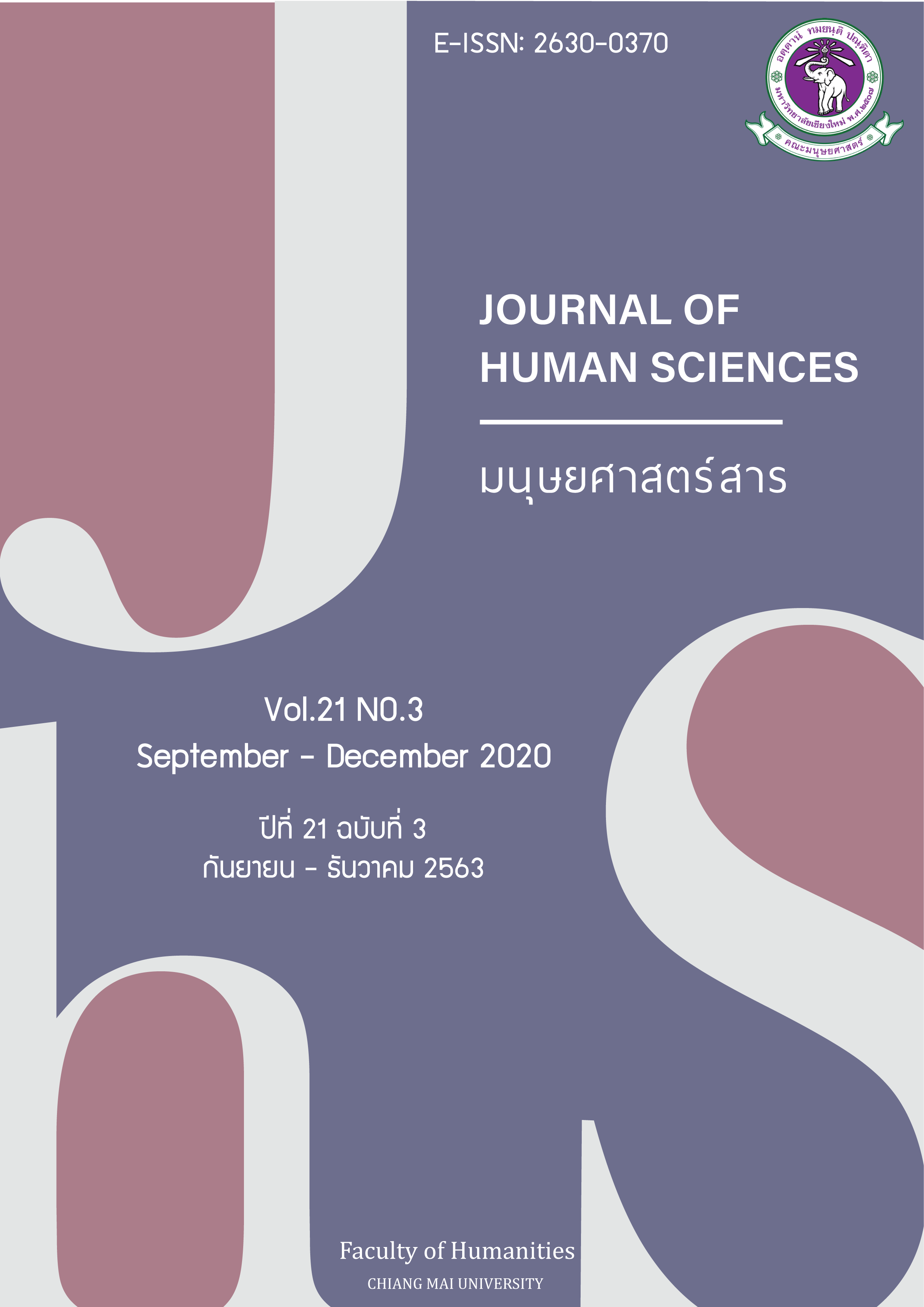ภาษาและอุดมการณ์ในวาทกรรมการปรึกษาเรื่องภาวะ “สับสนทางเพศ” ในชุมชนเสมือนจริง
Main Article Content
บทคัดย่อ
งานวิจัยนี้เข้าตรวจสอบอุดมการณ์และกลวิธีทางภาษาที่ใช้สื่ออุดมการณ์ในวาทกรรมการปรึกษาเรื่องภาวะ “สับสนทางเพศ” ในชุมชนเสมือนจริงตามแนวคิดวาทกรรมวิเคราะห์เชิงวิพากษ์ (Critical Discourse Analysis) ผู้วิจัยรวบรวมตัวบทวาทกรรมจากกระดานสนทนาในเว็บไซต์พันทิปจำนวน 324 ข้อมูล ผลการวิจัยค้นพบอุดมการณ์เบื้องหลัง 3 ชุด ได้แก่ อุดมการณ์เพศตามธรรมชาติ อุดมการณ์สารัตถะทางเพศ และอุดมการณ์ความเป็นกลางทางเพศ กลวิธีทางภาษาที่ใช้สื่ออุดมการณ์ปรากฏทั้งหมด 5 กลวิธี ได้แก่ การเลือกใช้คำศัพท์และวลี การใช้ชนิดกระบวนการ การใช้อุปลักษณ์ การสื่อมูลบท และการสื่อความหมาย ชี้บ่งเป็นนัย อุดมการณ์ที่ปรากฏต่างเข้าไปประกอบสร้างความหมายเรื่องเพศสรีระ เพศสถานะ และเพศวิถีแก่กลุ่มปัจเจกบุคคลในสังคมไทย ผลการวิจัยยืนยันว่า กลุ่มปัจเจกบุคคลในสังคมไทยไม่ได้เชื่อ และปฏิบัติตามอุดมการณ์ทางเพศชุดใดชุดหนึ่งอย่างเป็นเอกภาพ ผลที่ตามมาจึงทำให้ผู้ร่วมสนทนาในชุมชนเสมือนจริงพิจารณาเรื่องภาวะ “สับสนทางเพศ” ในมุมมองที่แตกต่างกันออกไป ในท้ายที่สุด งานวิจัยนี้เสนอว่า ไม่มีสิ่งที่เรียกว่า ภาวะ “สับสนทางเพศ” แต่การประกอบสร้างภาวะดังกล่าวก่อกำเนิดขึ้นมาจากการแทรกแซงของอุดมการณ์เพศตามธรรมชาติและอุดมการณ์สารัตถะทางเพศ ดังนั้นผู้วิจัยจึงเสนอให้ถอนทำลายการผูกติดภาวะ “สับสนทางเพศ” บนเนื้อตัวร่างกาย เพราะชุดความคิดนี้ถูกก่อรูปขึ้นเพื่อสร้างความแปลกแยกภายในตัวบุคคล อีกทั้งยังเป็นอุปสรรคต่อการยอมรับความหลากหลายและความเสมอภาคทางเพศ
Article Details
เอกสารอ้างอิง
Chairerk, W. (2015). Phasa lae udomkan khwampenchai thi prakot nai nittayasan chi-em: kansuksa wathakam wikhro chœng wiphak [Language and masculine ideology in GM magazine: a critical discourse analysis]. (Doctoral’s thesis, Naresuan university).
Chonwilai, S. (2013). rak song phet khong phuying thang luak khong khwampratthana lae kan khonha niyam attalak [Love of bisexual women: choice, desire, and sexual identity]. In N. Duangwiset, P. A. Jackson (eds.), phet lak chet si: phahu watthanatham thang phet nai sangkhom Thai [Cultural Pluralism and Sex/Gender Diversity in Thailand] (pp. 176-216). Bangkok: Princess Maha Chakri Sirindhorn Anthropology Centre.
Duangwiset, N. (2013). phet laklai nai sangkhom Thai kap kanmuang khong 7attalak [Sex/Gender Pluralism in Thailand and the Politics of Identity]. Journal of Social Sciences Faculty of Social Sciences Chiang Mai University, 25(2). 137-168.
____________. (2015) thopthuan withikan sang khwamru khwamching ruang phet [Review: construction of knowledge about sex, gender, and sexuality]. Retrieved from https://www.sac.or.th/databases/anthropology-concepts/articles/2
____________. (2017). chai num pen watthu thang phet lae kan prap khabuan phet withi nai lakhon chai rak chai [Male sexual objectification and adjustment of the sexual orientation in male homosexual dramas]. In N. Duangwiset (eds.), mua rang klai pen phet: amnat seriniyom mai khong phet withi nai sangkhom Thai [The Sexualized body: neoliberal power, new media trends and transnational East Asian influences on sexuality in Thailand] (pp. 188-233). Bangkok: Princess Maha Chakri Sirindhorn Anthropology Centre (Public Organization).
Fairclough, N. (2003). Analysing discourse: Textual analysis for social research. London: Routledge.
___________. (2010). Critical Discourse Analysis: The Critical Study of Language (2nd ed.). London: Longman.
Halliday, M. A. K. (1973). Explorations in the functions of language. London: Edward Arnold.
Kang, M., Lessard, D., Heston, L., & Nordmaken, S. (2017). Introduction to Women, Gender, Sexuality Studies. MA: University of Massachusetts Amherst Libraries.
Kavilanan, K. (2018). konlawithi thang phasa phua prakop sang khwamrak khongke nai botphleng prakop lakhon sirike: kansưksa tam naeo wathakam wikhro choeng wiphak [Linguistic Strategies for Gay’s Love Construction in Thai Gay Series Songs: A Critical Discourse Analysis Study]. Mekong salvin civilization journal, 9(2). 95-114.
Klinsuwan, K. (2013). khwamtaektang rawang chai-ying nai kanhaikhamnaenam panha chiwit rak nai hong Sala prachakhom wepsai phanthip dot khom: kansuksa wathakam wikhro chœng wiphak [Difference between men and women in relationship advisory discourse on salaprachakhom web board on www.pantip.com: a critical discourse analysis] (Master’s thesis, Chulalongkorn University).
Phanichtrakul, K. (2013). khwamsamphan rawang phasa kap udomkan waduai chai rak chai nai nangsu phim rai wan phasa Thai pi phoso 2555 [The relationship between language and ideology of male homosexuality in Thai daily newspaper in 2012: a critical discourse analysis] (Master’s thesis, Chulalongkorn University).
Mahittivanicha, N. (2019). khomun phuchai ngan su dichiton khong prathet Thai Makarakhom songphansipkao [Thailand digital usage 2019]. Retrieved from https://www.twfdigital.com/blog/2019/02/thailand-digital-usage-stats-2019
Mey, J. L. (2009). Concise encyclopedia of Pragmatics (2nd ed.). Oxford: Elsevier Science.
Nippanon, P. (2016). kansang phap tuathaen thom khong nittayasan @ tom actz rawang Pho So 2550-2559 [The construction of female trasgender “tom” stereotype in @tom actz magazine during
-2016] (Master’s thesis, Thammasat University).
Odrowaz Coates, A. (2015). Is gender neutrality a post-human phenomenon? The concept of gender neutral in Swedish education. Journal of Gender and Power, 3(1). 113-133.
Pakdeepasuk, P. (2010). wathakam khwampen phuying nai nittayasan sukkhaphap lae khwam ngam phasa Thai [Discourse of Femininity in Advertisements in Thai Health and Beauty Magazines]. Bangkok: Faculty of Arts, Chulalongkorn University.
Panpothong, N. (2013). wathakam wikhro chœng wiphak tam naeo phasasat: naeokhit lae kannam masuksa watthakam nai phasa Thai [Critical Discourse Analysis: concept and usage in Thai discourse]. Bangkok: Chulalongkorn University.
Parker, R. D. (2014). How to Interpret Literature: Critical Theory for Literary and Cultural Studies (3 ed). New York: Oxford University Press.
The National Discovery Museum Institute. (2019). phet haeng Sayam prawattisat hwamlaklai thang phet [Gender of Siam: history of sexual diversity]. Bangkok: The National Discovery Museum Institute.
UNICEF Regional Office for South Asia. (2017). gender equality: glossary term and concept. Leknath Marg: Kathmandu.
Wattanachaisriskul, N. & Lerlertyuttitham, P. (2017). phap thaen kanyomrap kan rak phet diaokan khong wairun chak raikan khlap fraide [Representation “Acceptance of Homosexual” ofteenager in Thai Societyfrom Club Friday Radio Program]. Liberal arts review, 12(23),75-83.
Wongchusap, S. (2019). Unisex mua faechan songsœm khwam thaothiam thang phet Unisex [Unisex fashion trends encourage gender equality]. Retrieved from http://www.thaifranchisecenter.com/document/show.php?docuID=5272
Wongthai, N. (2019). atthasatparichanbuangton [cognitive semantic]. Bangkok: world of print.


